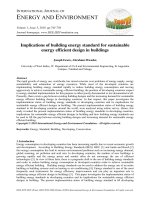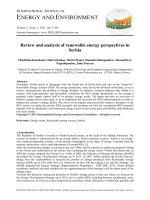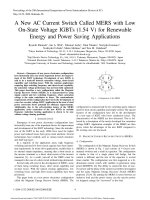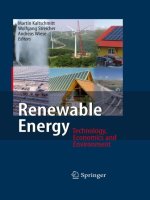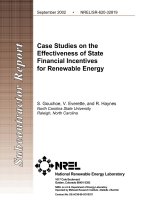“Creating Markets for Renewable Energy Technologies EU RES Technology Marketing Campaign“ docx
Bạn đang xem bản rút gọn của tài liệu. Xem và tải ngay bản đầy đủ của tài liệu tại đây (2.5 MB, 18 trang )
1
“Creating Markets for Renewable Energy Technologies
EU
RES Technology Marketing Campaign“
Supported by the European Commission - FP6
Bioethanol Production and Use
2
Brochure produced as part of the
Project: RESTMAC
Project Coordinator
EREC - European Renewable Energy Council
This publication is supported by the European
Commission and Co-funed by the European Commission
under the Sixth Framework Programme (FP6).
CONTACT NO: TREN/05/FP6EN/S07.58365/020185
Brochure produced by
EUROPEAN BIOMASS INDUSTRY ASSOCIATION
63-65 Rue d’Arlon
B-1040 Brussels
Tel : +32 2 400 10 20 Fax : +32 2 400 10 21
www.eubia.org
Contents:
Introduction p. 3
Bioethanol Production p. 4
1. Cereal & Sugar Crop p. 4-5
Production
2. Lignocellulosic Production p. 6
European Bioethanol Production p. 7
Bioethanol Co-Products p. 7-9
Bioethanol Use
- Chemicals p. 9
- Transport Fuel p. 10-13
- Fuel Cells p. 14
Bioethanol Engineering Companies p. 15
Politics & Concluding Remarks p. 16
Project Overview p. 18
Legal Notice
The sole responsibility for the
content of this publication lies with
the authors. It does not represent
the opinion of the Community. The
European Commission is not
responsible for any use that may
be made of the information
contained therein.
Project Partners
EWEA - European Wind Energy Association
EPIA - European Photovoltaic Industry
Association
ESHA - European Small Hydropower
Association
AEBIOM - European Biomass Association
EUBIA - European Biomass Industry
Association
EGEC - European Geothermal Energy
Council
ADEME - Agence de l’Environnement et de
la Ma•trise de l’Energie
NTUA - National Technical University of
Athens
ECB - Energy Centre Bratislava
GAIA - Consultores en gestion ambiental
ESTIF - European Solar Thermal Industry
Federation
Images on front cover from left:
TEREOS (Sugar Cane), TEREOS
(Bioethanol Plant) and UK
Agriculture.com (Wheat).
3
Introduction
In recent years, largely in response to uncertain fuel supply and efforts to reduce carbon dioxide
emissions, bioethanol (along with biodiesel) has become one of the most promising biofuels today
and is considered as the only feasible short to medium alternative to fossil transport fuels in
Europe and in the wider world. The current EU commitment under Directive 2003/30/EC on the
promotion of biofuels for transport set a target of 5.75% of all transport fuels by 2010. The
recent European Commission energy roadmap has now increased this to 10% by 2020.
Bioethanol is seen as a good fuel alternative because the source crops can be grown renewably
and in most climates around the world. In addition the use of bioethanol is generally CO
2
neutral. This is achieved because in the growing phase of the source crop, CO
2
is absorbed by
the plant and oxygen is released in the same volume that CO
2
is produced in the combustion of
the fuel. This creates an obvious advantage over fossil fuels which only emit CO
2
as well as other
poisonous emissions. In the 1970s, Brazil and the USA started mass production of bioethanol -
grown from sugarcane and corn respectively. Smaller scale production started more recently in
Spain, France and Sweden mostly from wheat and sugar beet.
In recent years the concept of the bio-refinery has emerged, whereby one integrates biomass
conversion processes and technology to produce a variety of products including fuels, power,
chemicals and feed for cattle. In this manner one can take advantage of the natural differences
in the chemical and structural composition of the biomass feed stocks. The Commission
document “An EU Strategy for Biofuels”
1
reports on this concept of the “bio-refinery” within the
Seventh Framework Programme (FP7) and it will give it high priority support. In the framework
of the RESTMAC project (“Creating Markets for Renewable Energy Technologies EU – RES
Technology Marketing Campaign“) which aims to develop and employ a comprehensive and well
thought-out thematic approach to encourage the uptake of selected RES technologies in the
market, this brochure will present information about the production of bio-ethanol and its co-
products, but will also focus the use of bioethanol and on some political issues. In this brochure
you can also find a list of the main actors in the bioethanol sector
1
“An EU Strategy for Biofuels”, European Commission,
/>4
Bioethanol Production
The production of bioethanol from traditional
means, or 1
st
Generation Biofuels is based
upon starch crops like corn and wheat and from
sugar crops like sugar cane and sugar beet.
However, the cultivation of alternative sugar
crops like sweet sorghum opens up new
possibilities in Europe, especially in hotter and
drier regions, such as Southern and Eastern
Europe. Sweet sorghum requires less water or
nutrients and has a higher fermentable sugar
content than sugar cane as well as a shorter
growing period which means that in some regions
like in Africa you can get 2 harvests a year from
the same crop. In addition to this, the
development of lingo-cellulosic technology has
meant that not only high energy content starch
and sugar crops can be used but also woody
biomass or waste residues from forestry. This
development is seen as the 2
nd
Generation of
Biofuels.
This process is still expensive by comparison to traditional bioethanol production. Bioethanol, or
rather ethanol, itself belongs to the chemical family – alcohols - and has a structure of C
2
H
5
OH.
It is a colourless liquid and has a strong odour.
Depending on the biomass source the steps generally include:
1. Storage
2. Cane crushing and juice extraction
3. Dilution
4. Hydrolysis for starch and woody biomass
5. Fermentation with yeast and enzymes
Sugar Cane
Today the processes of milling (cutting of cane into regular pieces) and raw sugar refining are
usually done together on one site. During the milling the sugar cane is washed, chopped and
shredded by revolving knives. The shredded cane (20-25cm) is fed into mill combinations which
crush and extract the cane juice. The juice is filtered and pasteurised (treatment of heat to kill
micro-bacterial impurities) along with chemicals. Bagasse, the waste matter from the cane sugar
Abengoa’s Ecocarburantes Espa…oles plant in
Cartagena, Spain, produces 100 million litres
of bioethanol
S†dzucker Bioethanol, based in Mannheim,
Germany supplies E85 grade bioethanol from
their recently commission
ed plant (Feb 2006)
at Zeitz which cost 200 million Euros. It
produces 260 million litres of bioethanol a year
from high value protein feed, mostly wheat.
6. CO2 storage and ethanol recapture
7. Evaporation
8. Distillation
9. Waste water treatment
10. Fuel Storage
S€dzucker Bioethanol
Abengoa
5
is used as a fuel for the bioethanol plant boilers and it can produce heat and steam on a self-
sufficient basis. The cane juice is filtered to remove vinasse – the unwanted non alcoholic black-
red liquid. Vinasse has been considered an annoying waste product and as a burden and
environmental hazard due to its viscous nature and high acid content. Some uses include
combustion and use as potassium fertilisers. After the vinasse is removed the syrup is then put
through evaporation and cooling crystalisation. It leaves clear crystals and molasses. The
molasses are separated from the crystals by centrifugation. And further pasteurisation and
fermentation processes take place before distillation to a higher concentration of alcohol.
Fermentation takes between 4-12 hours normally.
Cereal crops
For starch (cereal) based crops the procedure is similar to sugar crops but with the added
process of hydrolysis to break down the polymers into monomers which can then be broken down
into simple C6 sugars. From the milling of the grain to release the starch, it is then diluted into
water to adjust the volume of sugar in the mash. The mixture is cooked with yeast and all the
water soluble starches dissolve into the water. And through either acid hydrolysis or enzymes,
the starch is converted into sugars. The unrefined fermented liquid known as “beer”, is produced
and through various evaporation and distillation stages fuel grade ethanol can be produced.
Below is a diagram showing examples of the main crop sources for bioethanol. They can be
naturally divided into cereal crops, sugar crops and woody/lignocellulosic biomass. Any sort of
wood, crop residues or forestry waste like sawdust and chips can be used for 2
nd
Generation
bioethanol. Miscanthus and the other examples below are of some fast growing grasses which
are proving more and more popular for heating fuel. They could also be used for lignocellulosic
bioethanol.
6
Lignocellulosic Bioethanol
The difference in process steps between starch and lignocellulosic feedstocks is that
lignocellulosic biomass requires a more complicated hydrolysis stage. The reason for
this is that cellulose in the wood contains carbohydrate polymers called cellulose.
Cellulose is made up of long chains of glucose and a more complex set of enzymes
are required to break the long chains. Therefore lignocellulosic bioethanol is
technically more demanding and thus more expensive. Work at the moment is
ongoing to enhance the pre-treatment methods such as steam explosion, ammonia
steam explosion, acid processing and synthesising more efficient enzymes. Another
area for development is fractionation technology so one can use more variable
biomass, such as agriculture and forest crop residues and urban waste. The
chemical structure of the crop and forest residues are highly variable which creates
added complexity compared to the homogeneity of starch or sugar crops.
The concept of the biorefinery is seen as a very promising venture for the future.
The diagram above shows the complexity and substantial potential available from the
production point of view. The possibility of many different co-products and
chemicals from lingocellulosic bioethanol production has caught some attention. The
costs of large scale production are said to be 8-12 years away from realisation.
Much investment is going into the enzymatic study of breaking down the cellulosic
material and separating it from lignin. Syngenta, a Swiss company, has signed a 10
year contract worth $16m with American company, Diversa, for research and
development of enzymes for biofuels (Bioenergy Business, Feb 2007).
ECOREFINE (Biorefinery)
TECNIA, 2007
7
European Bioethanol Production
The table above shows the large players in bioethanol production in Europe. Abengoa is
by far the largest producer, followed by Sauter and S†dzucker. SEKAB has an important
place in the industry as they specialise in lingocellulosic bioethanol technologies and
production. They use wood residues from the paper pulp industry as well as surplus wine
alcohol as bioethanol feed stocks. This wine usage has been encouraged by the European
Commission in response to the present surplus in the wine industry in Europe. It is
expected to last for another 6-7 years. SEKAB also invests in bioethanol plants, especially
now in Hungary where they are investing 380 million € in 4 new bioethanol plants to
produce 600 million litres by 2008 from mainly maize and some wheat along. In addition
460,000 tonnes of animal feed will be produced as a co-product.
Bioethanol Co-products
Producer Country Capacity
(litres/yr)
Website Feedstock
Saint-Louis Sucre France 15,000,000
www.saintlouis-sucre.com Beet or Molasses
Cristal Union France 120,000,000
www.cristal-union.fr Beet
Tereos France 50,000,000
www.tereos.com/ Wheat and sugar beet
S†dzucker Germany 260,000,000
www.suedzucker.de Wheat
Sauter Germany 310,000,000
www.sauter-logistik.de Rye
Kwst Germany 30,000,000
www.kwst.com Sugar Beet or molasses
Abengoa Bioenergy Spain 510,000,000
www.abengoabioenergy.com Wheat
Agroethanol AB Sweden 50,000,000
www.agroetanol.se Wheat
SEKAB (formerly
Svensk Etanolkemi)
Sweden 100,000,000
www.sekab.se Wood waste and wine
alcohol
EUBIA & ABENGOA, 2006
www.vet
-
lyon.fr
DDG (Dried Distillers Grain) is an important co-
product from cereal bioethanol production. It is created
from drying the mash after all useful ethanol has been
extracted. It is used as feed for cattle. Also DDGS is a
soluble version made by adding water which is more
easily consumed by cattle. DDGS can usually be kept
for 2 to 3 days or 1 week by adding preservatives. The
dry, DDG can be stored indefinitely.
“DDGS is a high quality feedstuff ration for dairy cattle,
beef cattle, swine, poultry, and aquaculture. The feed is
a partial economical replacement for corn, soybean
meal, and dicalcium phosphate in livestock and poultry
feeds.” (www.ethanol.org)
8
EUBIA
NC State University
Companies specialised in Lignin based
products:
Borregaard LignoTech USA Inc.
www.lignotech.com/
Rayonier Performance Fibers
www.rayonier.com/
Tembec www.tembec.ca/
Temple Inland www.myinland.com/
See www.lignin.org for more information
Bagasse is the primary by-product from sugar
cane production. Bagasse is commonly combusted
in boilers or cogeneration systems in the sugar
industry for the production of heat in the mill for
sugar refining processes and for the production of
electricity for either direct use by the plant or to
sell to the national grid which can increase their
overall profit. About 35% of the weight of sugar
cane becomes bagasse. Brazil, India, China and
Thailand are the largest producers and utilisers of
bagasse.
Bagasse is a straw like material left from cane
sugar. It can also be used for making agro-pellets
which can be exported as a feedstock for home
pellet boilers or co-firing.
Straw is another important co-product from cereals
and has been used for centuries for various uses.
Straw is the waste part of the plant that does not
contain the grain and it makes up around 50% of the
plants weight. Historical uses include use for rope,
paper, packaging, thatching and bedding. It has
mostly been used for animal feed although recent
uses include biofuels in the lignocellulosic path to
bioethanol. It can also be used as a substrate for
biogas production through anaerobic digestion. Straw
has mainly been somewhat of a burden for farmers as
they had to dispose of it some way but its application
for bioethanol or biogas means they can sell this
waste as a marketable by-product.
Lignin products from lignocellulosic bioethanol
production are highly varied. Due to the nature
of the organic compound they have unique
strength to weight and elastic or adhesive
properties.
Lignin is the most important organic compound
for strength between cell walls in plants. Between
1/4 and 1/3
rd
of all dry tree mass is made of
lignin. It fills cells along with cellulose and some
other compounds and forms covalent bonds
between different polysaccharides thereby giving
mechanical strength to the whole plant. Lignin
can be used for a variety of uses and in varying
sectors.
9
Examples of Lignin Products and Uses
Category of Use Explanation/example of Application
Food & Perfumes Flavourings or scent for perfume, e.g. Vanilla (Borregaard)
Binder/glue Fertiliser, plywood, dust suppressants, ceramics
Dispersant Reduces binding with other sub
stances, e.g. Oil Drilling muds,
paints, dyes, pigments
Emulsifier
Mixes 2 immiscible liquids together, usually for a limited length of
time, e.g. the mixing of oil and water
Sequestrant Lignosulfonates can be used for cleaning compounds and for w
ater
treatments for boilers, cooling systems, micro-nutrient systems
The company Borregaard (Norwegian/USA) has a range of products based on vanillin
an organic compound more commonly known as vanilla in the foods and perfumes
sector. Producing vanilla naturally like this is proving more cost effective than the
synthetic route, i.e. through the petrochemical industry. The natural production of
rubber from the plant is a good example as many of its applications cannot be
synthesised petro-chemically. Lignin is largely produced as a by-product of the
paper industry, separated during the pulping process. Through the production of
bioethanol, this opens up a new line of production.
Bioethanol Use -
Chemicals
A number of chemicals are produced in the ethanol industry and potentially even
more in the 2
nd
generation bioethanol industry, serving a wide range of uses in the
pharmaceuticals, cosmetics, beverages and medical sectors as well as for industrial
uses. The market potential for bioethanol is therefore not just limited to transport
fuel or energy production but has potential to supply the existing chemicals industry.
SEKAB co-produce the following chemicals along with Fuel Ethanol:
1. Acetaldehyde (raw material for other chemicals e.g. binding agent for paints
and dyes)
2. Acetic acid (raw material for plastics, bleaching agent, preservation)
Ethylacetate (paints, dyes, plastics, and rubber)
3. Ethanol 95% (foods, pharmaceuticals, fuel ethanol, detergents)
4. Thermol (cold medium for refrigeration units and heat pumps) (SEKAB, 2007)
KWST also provide a range of chemicals mixed into marketable compounds such as:
1. Ethyl Alcohol (ethanol) (spirits industry, cosmetics, print colours and varnish)
2. Isopropyl alcohol (IPA), Ethyl acetate (EAC), WABCO-antifreeze (disinfectant,
cleaning agent for electronic devices, solvents)
3. Vinasse, Potassium Sulphate (feeding stuffs, fertilizer) (KWST, 2007)
10
Transport Fuel:
Bioethanol has mostly been used as a biofuel for transport, especially in Brazil.
Indeed it was in Brazil where the first bioethanol fuelled cars emerged on a large-
scale. Although generally unknown to the average consumer, a large volume of
bioethanol is already used in Europe as it is blended with petrol at 5%. It is used as
a substitute for lead as an oxygenating additive and has a high octane rating, which
improves performance. Although the eventual target is the private consumer, few
are aware of bioethanol’s potenial to, at least, partly replace petrol as a transport
fuel in Europe.
Stakeholders in the Bioethanol Fuel Market:
bioethanol producers
fuel suppliers
car manufacturers
the government - support is also
extremely important as was the case
in Brazil in the late 1970s and in the
USA today bioethanol has been
endorsed by the President and helped
by subsidies and tax breaks
transport users
In addition supermarkets who provide petrol stations to customers are seeing the
opportunity to provide petrol/ethanol blends from 5-85% (E5 –E85). Even though
most experts agree that up to a 10% mix will not damage modern car engines, the
manufacturer warranty for standard cars is set at 5%. Above this level to maintain
the warranty, the car engines need to be modified or one has to buy a fuel flexible
vehicle (FFV).
Fuel ethanol in Europe:
Sweden is the strongest in the bioethanol transport
market with over 792 E85 (BAFF, March 2007) fuel
stations and 15,000 Ford Focus FFVs have been sold there
since it’s debut on the market in 2001. By May 2006,
15% of all newly sold cars were either bioethanol or
biogas fuelled vehicles. E85 is being sold at prices
substantially less than petrol, between 75 and 85 € cents
per litre compared to 1.11 € and 1.19 € for petrol. An
important consideration when marketing the price of
bioethanol is the fact that ethanol contains around 30%
less energy per litre than petrol which means you have to
fill up more frequently. Therefore the sale price will have
an important impact on take-up of bioethanol as a
transport fuel.
E85 Pump station
Morrisons PLC
Fuel Energy Content
(kJ per litre)
Petrol 32 389
Diesel 35 952
Ethanol 21 283
E85 22 950
11
Number of E85 Fuel Stations
792
4
1 1
73
6
14
36
16
3
500-600
0
100
200
300
400
500
600
700
800
S
weden
Germ
a
ny
F
r
a
nc
e
Ireland
UK
Swit
z
erland
Spain
Ne
ther
l
a
nds
Italy
No
rway
Number of E85 Fuel
Stations
Number of Planned
E85 Stations
Elsewhere in Europe, there are at present (March 2007) 73 bioethanol petrol
stations in Germany serving E50, E85 or E100. Morrisons Supermarket chain in
the UK supply E85, available from 14 forecourts in the South of England (see photo
above) marketed at 2 pence below petrol. However, their bioethanol is supplied
from Futura Petroleums, which all comes from Brazilian fuel stocks. Despite the
distances involved, it is still competitive to import bioethanol from across the
Atlantic instead of producing it locally.
The graph above shows the leading countries in bioethanol fuel stations in Europe.
Sweden is by far and away the largest proponent for bioethanol as a transport fuel.
Germany is progressing faster than most and the rest sell E85 at only a handful of
service stations often to support private vehicles such as police or governmental
fleets around the more densely populated areas. In 2007 we can expect to see a
substantial increase in some of these countries, especially in France where the
government has mandated the introduction of 500-600 E85 service stations.
12
The map and figures above gives you a brief overview of the bioethanol fuel market
and the density of E85 stations in comparison with petrol stations. The number of
service stations per 10,000 persons gives a useful comparison. While the total
number of petrol stations has declined dramatically over the last 20 years, being half
or even one third of what they once were, the bioethanol stations are still very low in
comparison as they are just starting to appear in Western Europe with the exception
of Sweden. There, the first E85 filling station appeared in 1995 but steady
expansion started only in 2002 (Saab, 2006).
Transport Fuel in the USA:
Depending on the state policy and natural
resources, E85 is being used to a varying
degree across most states. Some states
where E85 service stations are fewer in
number serves E85 only to governmental and
private fleets such as in parts of California,
whereas there is a very impressive publicly
available E85 infrastructure around the
American corn belt (Iowa, Illinois, Nebraska,
Minnesota, Indiana, Wisconsin, South Dakota,
Michigan, Missouri, Kansas, Ohio and
Kentucky) which is shown by the blue, grey
and brown colours in the following map.
E85 Filling Stations in the USA
(EERE, US Department of Energy, March 2007)
13
Manufacturers of bioethanol fuelling vehicles:
Ford are the only mass producer of Flexi-fuel vehicles in Europe, led by the Focus
and C-Max models. Saab and Volvo started offering an alternative from 2005 and
2006, respectively, with their Flex-fuel bioethanol cars. Both Swedish companies in
fact offer a biogas fuelled model as well. Scania has also a series of E85 fuelled
buses and trucks.
The USA has already a large number of car manufacturers selling fuel-flexible
vehicles: Ford, Chrysler, General Motors, Isuzu, Mazda, Mercedes, Mercury and
Nissan. And in Brazil the companies Fiat, Ford, General Motors, PSA, Renault,
Volkswagen serve the national E85 vehicle needs.
The Ford Focus FFV (see left) has been
marketed around the same price as the basic
petrol model. The commercial potential of the
car has received a boost by the Avon and
Somerset (UK) Police who bought 15 of the fuel
flexible Focus’ in March 2006. Further interest
has been shown by other regional police forces
throughout the United Kingdom. The
advantage is that they are still able to refuel
from petrol at any percentage, thus not limiting
their range to where the bioethanol pump
infrastructure does not reach. Ford reports
there is a 70% reduction in CO
2
emissions
compared the petrol version.
The Focus FFV, and C-MAX although released in
2001 in Sweden, only became available in the UK
in September 2005 and it is still yet to be released
to the dealerships in the UK on a large scale.
However it has enjoyed substantial success in the
Swedish car market since its introduction. Swedish
car marker, Volvo, has two models that run on
bioethanol, those being the S40 (see opposite) and
V50. Neither of them are, as yet, widely available
in countries outside Sweden.
Saab has a 9-5 biofuel saloon and estate model
that can run on E85. There are a small number of
these biopower models available at selected
dealerships in the South and East of England where
there is a small E85 fuel pump infrastructure via
the Morrisons supermarket chain. Saab has in
2006 produced a bio-hybrid electric engine that will
work on E100, first shown at the Stockholm motor
show and based on the Saab 9-3 model. By the
end of 2007, Renault, Peugeot and Citroen will
have their own fuel-flexible vehicle ready for the
market in line with the government’s mandated
E85 infrastructure plans for 2007.
Ford Focus, Ford Motor Company
Saab 9
-
5 Biopower
, ww.ethanol360.com
S40 FFV Volvo, Volvo
14
Fuel Cells:
Fuel cells are another potential area for ethanol use to
produce heat and power. Fuel cells function by
combining the fuel hydrogen with oxygen from the air
to produce electrical energy, with water vapour and
heat as by-products. Fuel Cells have a typical
electrical efficiency of between 30 and 60 % and an
overall efficiency, if using the heat by-product, of 70-
90 %. The units run with very low noise emissions
and pollutant gas emissions are also reduced
considerably. It’s disadvantages are its relatively high
cost and their short life span (regular replacement of
components). They are, however, regarded as very
reliable for the duration of their lifespan and are often
used for emergency power. Some uses of fuel cell
CHP systems include providing heat and power for
hospitals, university campus’, remote
telecommunication stations as well as for transport,
stationary power generation and residential buildings.
The recent growth in small residential (0.5 to 10 kWe)
fuel cell CHP is based on natural gas fuelled units.
A number of fuel cells can use bioethanol as well as fossil fuels, sometimes with,
sometimes without the need for a reformer (to convert it to hydrogen). Acumentrics
(USA) and Ceramic Fuel Cells (Australia) manufacture such fuel cells.
Acumentrics manufacture a fuel cell suitable for residential and other small-scale use
with 5 and 10 kWe capacities. They can be set to 120 or 240 volts depending on
needs. The start up time is from 10 to 30 minutes. The fuelling options are
impressive as it can take propane, natural gas, ethanol, methanol, methane and
hydrogen. Sulzer Hexis are responsible for the majority of SOFC installations in the
world. They are working on a CHP system, 1 kWe, 2.5 kWth with an additional
burner to provide for the heat requirements of the home.
Types of Fuel Cell:
Molten Carbonate Fuel Cells (MCFC)
Solid Oxide Fuel Cells (SOFC)
Polymer Electrolyte Fuel Cell (PEFC) aka
Proton Exchange Membrane Fuel Cell (PEMFC)
The ideal situation is where one uses pure
hydrogen as the fuel. This creates energy
and water vapour as products – as is
demonstrated in the PEMFC diagram.
However many fuel cell units are designed
to take fossil fuels like natural gas,
propane, methanol or butane. Here CO
2
is
additionally produced with water vapour.
The obvious advantage is the fuel flexibility
and equally obviously, the disadvantage is
the emitted CO
2
.
Phosphoric Acid Fuel Cells (PAFC)
Alkaline Fuel Cells (AFC)
Acumentrics
Sulzer Hexis
Fuel Cell Today
PEMCF energy exchange diagram
15
Bioethanol Engineering Companies
The complexity of a bioethanol plant is considerable and it therefore requires dedicated planning and expertise to build one, so
the majority of bioethanol plants are built upon specification by a contracted engineering company (specialising in bioethanol),
rather than by purchasing individual component units (Details of individual component manufacturers can be found in a
number of publications such as the Sugar Industry Buyers Guide, Spring 2006). Firms that provide the complete design
to construction service are listed below.
Company Country Website Email Address Telephone Number Fax Number
Vogelbusch GMBH AT www.vogelbusch.com ,
+ 43 1 54 661-0
+ 852 2314 3030
+ 1 713 461 7374 (USA)
+ 43 1 545 29 79
+ 852 2314 0369 (HK)
+ 1 713 461 7374 (USA)
Lurgi DE www.lurgi.com/ +49 (69) 58 08-0 +49 (69) 58 08-38 88
GEA Wiegand DE www.gea-wiegand.com + 49 7243/705-0 + 49 7243/705-330
TECNIA PT www.tecnia.net +351 261 912 470/1
+966 1 218 1460 (Saudi
Arabia)
+351 261 912 472
+966 1 218 1461
Chematur Engineering SE www.chematur.se/ +46 586 641 00 +46 586 791 700
Bayer Technology Services DE www.bayertechnology.com/
+49 214 30-50100 (Germany)
+49 214 / 30-1
+32 3 540 79 92 (BENELUX)
+86 21 67120280 (CHINA)
+ 1 877-229-37 87 (USA)
+32 3 540 37 78
(BENELUX)
+86 21 67120393
(CHINA)
Delta-T Corp. USA www.deltatcorp.com/ +1 (757) 220-2955 +1 (757) 229-1705
Praj Industries India www.praj.net/ +91-20-22951511 +91-20-22951718
MW Zander UK/DE www.mw-zander.co.uk/ +44 1249 455150 +44 1249 657995
Parker, Messana &
Associates, Inc.
US www.pma-engr.com/ +01 253 926 0884 +01 253 926 0886
BBI International US www.bbibiofuels.com +01 719 539 0300 +01 719 539 0301
16
Politics
The Biofuels Progress Report (Brussels, [9.1.2007] COM(2006) 845 final) from the
Commission has stated that it doesn’t expect the biofuels target of 5.75 % to be met
in 2010. The average member state achieved 52% of its target in 2005 where only
2 member states met their target of 2% biofuels in the national mix. Although
biofuels are not the most cost effect fuel, they are the only practical means for
reducing the EU’s dependence on oil. It should be said that the production of
biofuels does not automatically equate in CO2 savings as it depends on the land
management employed. If the energy crop has replaced natural rain forest the
effects would be negative not only on CO2 sequestration but also on native
biodiversity and habitat areas. The energy crops need to be thoughtfully planted on
appropriate land. Responsible bioethanol production can provide diversification of
energy supply and energy security while also creating employment in the many
process jobs involved in the industry.
Further actions to reduce emissions in the EU were reinforced by the European
Commission’s call for vehicle manufactures to reduce car CO
2
emissions to 120g/km
by 2012 from 2004 levels of 163g/km
2
. The role of bioethanol for transport fuels
could also make an important impact on CO
2
reduction from transport. The
technology side is seen as a critical area for reducing transport CO
2
as it is
acknowledged that mobility, in the EU, will certainly not decrease but increase with
time.
Concluding Remarks:
The opportunity to reduce dependence on fossil fuels, while reducing CO
2
is of
strategic important today. Since there is increased consensus among experts on the
reality of human induced global warming and the repercussions which are associated
with it, the potential to use carbon neutral fuels like bioethanol can help us stop (or
slow down) this negative impact on the environment. As long as the plantation of
the bioethanol feed stocks are done in a sustainable way without compromising
native species habitats and endangering the local biodiversity, there is no reason
why bioethanol cannot be one of the energy solutions for today.
The potential for bioethanol to create jobs is immense in farming, biorefineries, the
chemical industry, the fuel supply sector as well as fuel-flexible vehicle engineering.
The economic climate is ripe for investing in bioethanol production in Europe mostly
for fuel ethanol but also for the chemical use and stationary power generation. The
bioethanol by-products provide a useful side revenue through feedstocks for animal
feed, power generation and as a feedstock for 2
nd
generation bioethanol.
2
European Commission Press Release IP/07/155, 07/02/2007,
/>17
18
RESTMAC
“Creating Markets for Renewable Energy Technologies
EU - RES Technology Marketing Campaign“
PROJECT OVERVIEW
The project aims at developing and implementing a concise, well-targeted and
thematic approach to ensure the uptake of selected RES technologies in the market. In
other words the consortium works towards establishing a technology marketing
campaign for the different RE technologies involved. So far the market uptake of R&D
results does not happen in the best possible way. Lack of information and use of
synergies between stakeholders (industries, governments, consumers) is still seen as
the critical barrier to large-scale RE technology use in the market place. RESTMAC
aims to reverse this trend by:
A sectoral approach with the objective of promotion and valorization of
selected technologies with relevant and strong socio-economic potential;
A geographical approach with the identification of key market areas where
those technologies first selected could be largely deployed;
More specifically the project will look at renewable electricity technologies, renewable
heating and cooling technologies and thirdly, the production and distribution of liquid
biofuels. A key objective of the project is also to target new member states in the
EU and European Islands, along with Asian states and the Mediterranean area where
there is significant potential for RES which is as yet un-harnessed. For more
information visit the website:
www.erec-renewables.org/projects/proj_RESTMAC_homepage.htm
The renewable energy sectors to be marketed include:
PV (photovoltaic)
SHP (Small Hydro Power)
Biomass
Geothermal
Solar Thermal
Wind Power
The biomass part of the project focuses on some selected areas that have great
potential for the European biomass market and energy sector. EUBIA is responsible
for brochures number 4 and 5 while AEBIOM is responsible for the other three:
1. Pellets for Small-scale Domestic Heating Systems
2. New Dedicated Energy Crops for Solid Biofuels
3. Procurement of Forest Residues
4. Co-generation at Small-scale
5. Bioethanol Production and Use
